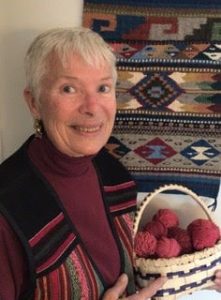Reds, Glorious Reds: The Cultivation and Use of Cochineal for Dye in Oaxaca, Mexico
Cochineal is a scale insect that lives on the pads of Prickly Pear Cactus (genus Opuntia) and
whose body and eggs contain carminic acid, an historically important natural dye. To the Maya and Aztec people of Mexico and Central America, cochineal dyed textiles were created as early as the second century BC and dried cochineal insects were paid first as annual tribute to Montezuma in the 15th century as recorded in Codex Osuna. Second only to silver in value, cochineal was then sent back to Spain by the conquistadores after they defeated this powerful ruler. Spain maintained a monopoly on this magnificent red dye source for several hundred years. Carmine, a dye and pigment produced from cochineal, was used to dye Catholic cardinals’ robes and the uniform jackets of English Redcoats.
Having dyed with imported cochineal for years before traveling to Oaxaca, Mexico, for the 10th International Shibori Symposium in 2016, Kris was particularly interested in seeing cochineal being raised commercially on a farm south of the city. In nearby Teotitlan de Valle, a Zapotec town famous for its handwoven rugs, those weavers using natural dyes often include shades of orange, red, pink and purple produced by cochineal insects in their rugs. Take a virtual trip to a Mexican cochineal farm to learn more about the history and use of these amazing (female!) insects and see examples of the rugs that glow with the cochineal dye colors.
 About Kris Nardello
About Kris Nardello
Blending advanced degrees in both art and science education, dyer, weaver, spinner, quilter and retired middle school teacher, Kris is often found foraging for native California plants and mushrooms for her natural dye pots. The dyed yarns are used for weaving small tapestries and rugs using traditional Scandinavian patterns as well as knitted garments. The indigo-dyed shibori and eco-printed fabrics are used for boro stitched bags, pieced quilts, garments and fabric collages. She has studied Zapotec rug techniques and symbology with Porfirio Gutierrez and works in Martha Stanley’s studio with 5 other weavers. Kris is currently the secretary of the Santa Cruz Textile Arts Guild, part of the Northern California Handweavers Guild.